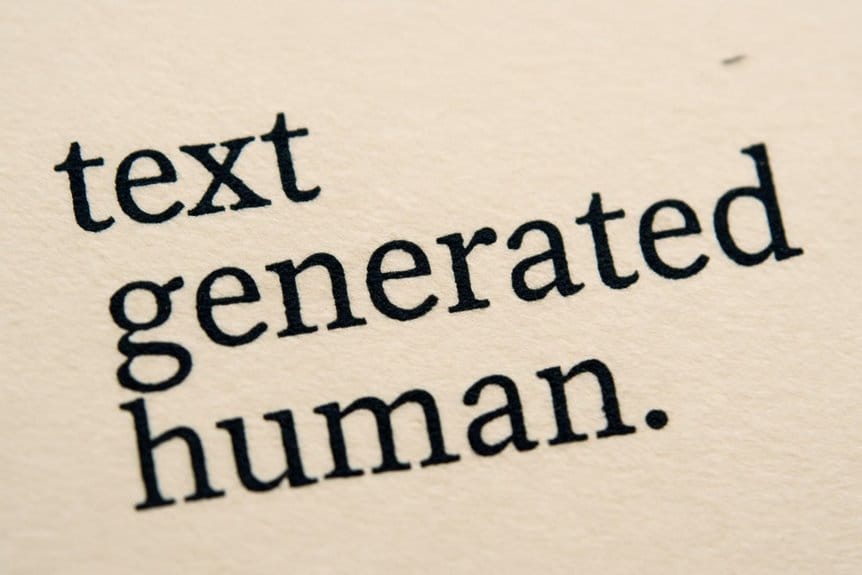AI writing tools closely mimic human prose. Advanced algorithms generate coherent content. Performance on factual reporting can lack authenticity due to limited contextual awareness. Creative flair and emotional depth remain challenging for AI. Dialogue generation reveals subtle differences. Mimicry depends on data and algorithms. Consistent tone enhances perceived authenticity, but truly surprising readers is difficult. Understanding these nuances offers a clearer picture.
Key Takeaways
- AI can mimic human writing but struggles with genuine context.
- AI struggles with creative originality and emotional depth.
- AI content authenticity depends on data and algorithms.
- AI can enhance content but doesn’t replace human creativity.
- Nuance, metaphor, and unique voice remain AI challenges.
The AI Writing Landscape

The AI writing landscape has undergone a dramatic shift. Advanced algorithms now possess the capability to generate text that closely mimics human writing, impacting various sectors from marketing to journalism. This advancement introduces significant ethical considerations, particularly concerning authorship and potential misinformation. As AI-generated content proliferates, maintaining user trust becomes paramount. Transparency about the origin of content is crucial to foster this trust. The use of AI tools like Squibler to accelerate creative efficiency highlights the balance between innovation and preserving artistic integrity. The ability of AI to scale content production infinitely raises questions about the future of human creators and the intrinsic value of originality. Steering these changes requires careful thought regarding the responsible deployment of these powerful tools.
Our Testing Methodology

When evaluating the capabilities of modern AI writers, what criteria best distinguish authentic human prose from artificial generation? To answer this, a rigorous testing methodology was developed. This approach focused on identifying subtle linguistic nuances and gauging stylistic variability across different prompts. Several AI writing models were tasked with generating content on a diverse range of topics, each requiring distinct tones and formats. Human evaluators, blind to the source of the text, were then employed to rate the generated pieces. These ratings considered factors such as creativity, emotional resonance, coherence, and the natural flow of language. By leveraging audience segmentation, the testing also ensured that AI writers could produce content tailored to different demographic and interest groups, enhancing the relevance and engagement of the output. The objective was to pinpoint specific areas where AI output diverged most notably from human writing patterns, thereby illuminating the current limitations and strengths of these sophisticated tools.
Performance on Factual Content

Precisely where do current AI writers falter when tasked with presenting factual information? While AI can readily access and synthesize vast datasets, its ability to convey factual content with genuine human-like understanding remains a work in progress.
The challenge lies in preserving the delicate linguistic nuances that convey meaning beyond literal interpretation. AI often struggles with subtle contextual shifts, idiomatic expressions, and the implicit understanding that underpins human communication.
Moreover, the integration of specific cultural references, which require a deep seated awareness of shared societal knowledge, can be particularly problematic. Without this lived experience, factual reporting can feel sterile or even misinterpret cultural touchstones, leading to inaccuracies or an overall lack of authenticity in the rendered text.
AI writers, through AI-driven personalization, have the potential to enhance content relevancy by dynamically customizing content based on customer behavior and preferences.
Capturing Creative Flair
Beyond the domain of factual reporting, AI writers encounter a different set of hurdles when attempting to imbue text with creative flair. The subtle art of storytelling, the use of metaphor, and the evocation of imagery often prove elusive.
While AI can mimic patterns, capturing the intrinsic spark of human creativity—the unexpected turn of phrase, the resonant insight—remains a significant challenge. This endeavor requires more than just statistical analysis; it demands an understanding of literary nuance.
Achieving true stylistic diversity, moving beyond predictable structures to generate genuinely original and evocative prose, represents a frontier AI is still actively exploring. AI story generators often lack originality, emotional depth, and nuanced insight compared to human writing. The ability to consistently surprise and delight a reader with an author’s unique voice is where the current limitations are most apparent.
The Emotion Spectrum
How can AI writers effectively navigate the vast spectrum of human emotion? Achieving genuine emotional resonance requires more than simply identifying feelings. It necessitates a nuanced understanding of how emotions manifest through language.
AI models must master tone variation to convey subtle shifts in sentiment, from jubilation to sorrow, reflecting the complexities of human experience.
The challenge lies in imbuing text with emotional depth, moving beyond surface-level descriptors. This involves:
- Contextual understanding: Recognizing how situations elicit specific emotional responses.
- Empathy simulation: Crafting language that reflects an understanding of characters’ inner states.
- Sensory integration: Utilizing descriptive language that evokes emotional connections through sensory details.
Successfully replicating these elements is vital for AI writers aiming to connect with readers on an emotional level.
AI content generators like Writecream, with its advanced AI tools, employ features such as tone variation and empathy simulation to achieve a deeper emotional connection in text.
Identifying AI in Dialogue
While AI writers can convincingly mirror human emotion, distinguishing their dialogue from that of human authors presents a unique set of challenges. A key differentiator lies in subtle linguistic nuances. AI often struggles with the organic imperfections of human speech, such as natural pauses, hesitations, or the spontaneous use of colloquialisms.
Moreover, a deep contextual understanding is essential. Human writers intuitively grasp the implicit layers of meaning, social cues, and shared cultural knowledge that inform genuine conversation. AI, while improving, may sometimes produce dialogue that, while grammatically correct, lacks the underlying resonance or subtle subtext that a human would naturally embed, leading to a detectable artificiality. Using AI insights can help enhance the quality and relevance of AI-generated content by providing data-driven content optimization, making it more aligned with human standards.
Factors Influencing Authenticity
When evaluating the authenticity of AI-generated text, several essential factors come into play. The degree to which an AI can mimic human expression is often tied to its programming and the data it was trained on. Sophisticated algorithms are vital for capturing subtle linguistic nuances that define natural communication. Vocabulary and sentence structure: Varied and appropriate word choice, alongside complex yet understandable sentence construction, contributes markedly to human-like prose. Contextual awareness: An AI’s ability to maintain a consistent tone and understand the underlying purpose of the text is paramount. Emotional resonance: While difficult to replicate perfectly, the subtle expression of emotion or empathy within the writing can enhance perceived authenticity. Moreover, effective AI tools preserve meaning, enable customization, and support seamless content enhancement.
The Future of AI-Assisted Prose
Understanding these elements of plausible AI writing naturally leads to considerations of what lies ahead. The trajectory of AI-assisted prose points towards increasingly sophisticated tools capable of generating nuanced and contextually appropriate content. This advancement, however, necessitates a careful examination of potential AI bias, which could inadvertently perpetuate existing societal inequalities within written works. Furthermore, the widespread adoption of AI in writing raises significant ethical concerns regarding authorship, originality, and the very definition of creative expression. Steering these challenges will be vital in shaping a future where AI serves as a powerful augmentative tool, rather than an unexamined replacement, for human creativity and communication. The ongoing dialogue surrounding AI bias and ethical concerns will undoubtedly inform the development and deployment of these technologies. Moreover, advancements in natural language processing are driving AI writing assistants to generate high-quality, coherent content with minimal human intervention.

